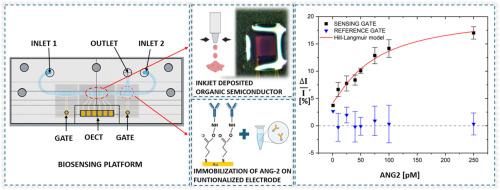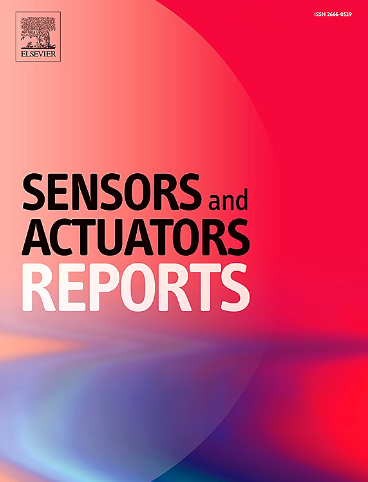A contamination-free electrolyte-gated organic transistors platform for high-accuracy tumor biomarker detection
IF 7.6
Q1 BIOTECHNOLOGY & APPLIED MICROBIOLOGY
引用次数: 0
Abstract
A novel biosensor platform for high-accuracy tumor biomarker detection exploiting contamination free microfluidics for increasing the signal-to-noise ratio has been successfully developed and tested. Electrolyte-gated organic Transistors (EGOT) has been employed to detect an important tumor marker, Angiopoietin-2 (Ang2). Although organic semiconductors have become popular in the last years in biosensing applications due to their many advantages, there is still a main concern about stability and selectivity. This work presents major improvement in terms of the stability and selective detection of Ang2 in the range of interest for biomedical applications. The semiconducting polymer poly[3-(5-carboxypentyl)thiophene (P3CPT) is deposited by picoliter volume control and micrometer diameter of the droplet to allow for high uniformity and repeatability from sample to sample. The optimized gold electrodes improve the detection of the minimal concentration of the target and microfluidic interfacing by a specific pattern with the desired dimensions is obtained by UV-lithography and wet etching. A microfluidics with multiple flow control allows for maintain a constant fresh solution without analytes on reference gate electrode, while another inlet and functionalized gate is used for sensing, thus reaching high stability and reproducibility. All these (four) optimizations lead to new measuring protocol and new 3D printed top cover that ensure better stabilization and repeatability of the results. The device has successfully detected Ang2 concentrations as low as 10 pM in saline, therefore demonstrating the ability of the device to detect clinically relevant concentrations.

一种用于高精度肿瘤生物标志物检测的无污染电解门控有机晶体管平台
一种利用无污染微流体提高信噪比的高精度肿瘤生物标志物检测的新型生物传感器平台已经成功开发和测试。电解质门控有机晶体管(EGOT)已被用于检测重要的肿瘤标志物血管生成素-2 (Ang2)。尽管近年来有机半导体因其诸多优点在生物传感应用中越来越受欢迎,但其稳定性和选择性仍然是一个主要问题。这项工作提出了Ang2在生物医学应用范围内的稳定性和选择性检测方面的重大改进。半导体聚合物聚[3-(5-羧基戊基)噻吩(P3CPT)通过皮升的体积控制和微米直径的液滴沉积,以保证样品之间的高均匀性和可重复性。优化后的金电极提高了对目标最小浓度的检测,并通过紫外光刻和湿法蚀刻获得了具有所需尺寸的特定图案的微流控界面。具有多流量控制的微流体允许在参考栅电极上保持恒定的新鲜溶液而不需要分析物,而另一个入口和功能化栅用于传感,从而达到高稳定性和可重复性。所有这些优化导致新的测量方案和新的3D打印顶盖,确保更好的稳定性和结果的可重复性。该设备已成功检测到生理盐水中低至10 pM的Ang2浓度,因此证明了该设备检测临床相关浓度的能力。
本文章由计算机程序翻译,如有差异,请以英文原文为准。
求助全文
约1分钟内获得全文
求助全文
来源期刊

Sensors and Actuators Reports
Multiple-
CiteScore
9.60
自引率
0.00%
发文量
60
审稿时长
49 days
期刊介绍:
Sensors and Actuators Reports is a peer-reviewed open access journal launched out from the Sensors and Actuators journal family. Sensors and Actuators Reports is dedicated to publishing new and original works in the field of all type of sensors and actuators, including bio-, chemical-, physical-, and nano- sensors and actuators, which demonstrates significant progress beyond the current state of the art. The journal regularly publishes original research papers, reviews, and short communications.
For research papers and short communications, the journal aims to publish the new and original work supported by experimental results and as such purely theoretical works are not accepted.
 求助内容:
求助内容: 应助结果提醒方式:
应助结果提醒方式:


